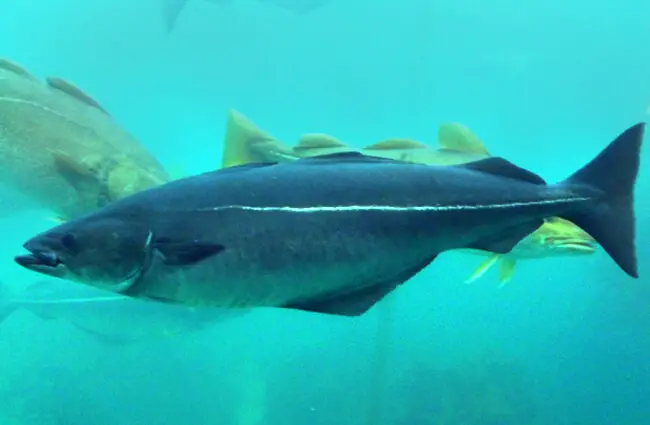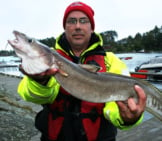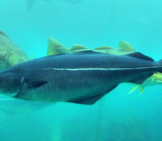A Coley is a species of pollock in the taxonomic genus Pollachius. People simply refer to the other member of the genus, P. pollachius, as “pollock.” These fish, also known as Coalfish, Boston Blues, and Saithes, have commercial fishery value. However, people do not target them as heavily as haddock or cod. Read on to learn about the Coley.
Description of the Coley
This torpedo-shaped fish has three triangular dorsal fins. It has something of a pot-bellied appearance, though not as dramatically evident as in cod. Its scales have a grey coloration, with darker color on their backs and lighter color on their underbellies.
This species measures between one and four feet long. The largest recorded individual weighed a whopping 70 lbs.
Interesting Facts About the Coley
This species has a number of interesting traits and characteristics. Learn more about what makes this fish unique, below.
- What’s in a Name? – This fish, also known as a “coalfish” doesn’t get its name by the color of its skin. Well, not exactly at least! While most members of the Gadidae family have white-colored flesh before cooking, the meat of this species has a gray coloration, hence the name.
- In the Family – Speaking of the Gadidae family, the close relatives of this fish, and other members of Gadidae, include the haddock, whiting, cod, and more.
- Lower Value – When compared to other members of the family, like cod and haddock, this species has a much lower value per pound. The color of their meat likely leads to poor opinion of the species, though it does have commercial value.
- Seelachs – In order to combat this poor rep’, fishermen in Germany sell this species under the name “Seelachs.” This term translates to “sea salmon” despite the fact the two have no close relation. The name change helps boost the value of the fish.
Habitat of the Coley
These fish prefer living in the water column, rather than remaining near the sea floor or the surface, making them pelagic. Younger fish live closer to the shore, particularly in intertidal areas, while larger adults range into deeper waters. Most individuals prefer shallow waters, but they range as far as 650 ft. deep.
Distribution of the Coley
You can find this species across the northern Atlantic. They live on both the North American and European sides of the ocean. Their range extends from the Northeast United States up the coast of Canada to Greenland and Iceland. They also frequent the coasts of Europe up to northern Norway.
Diet of the Coley
This species has carnivorous feeding habits, and preys on other animals. Their diet varies based on their age and where they live. Younger fish feed on smaller prey, such as plankton, krill, and other small invertebrates. Juveniles hunt for shrimp, crabs, and other crustaceans, as well as small fish and worms. Adults hunt for larger creatures, primarily targeting other fish.
Coley and Human Interaction
Humans utilize this fish species as a commercial source of food. People often target haddock and cod at a higher rate, though some use this species in place of the other two in recipes. Fishermen sell the meat fresh, frozen, dried, canned, or in brine.
Unfortunately, human activity, primarily overfishing and habitat destruction, put pressure on this species. Destruction of intertidal zones – where juveniles grow – has resulted in population decline.
Domestication
Humans have not domesticated this fish in any way.
Does the Coley Make a Good Pet
No, you would not want to keep this large fish as a pet.
Coley Care
Aquariums keep this species in huge saltwater tanks with plenty of space to swim. As social fish, they live in schools, and aquarists often house their schools with similar species. They maintain similar temperature, sunlight, and pH to their natural habitats. The aquarists feed them a variety of fish, squid, and crustaceans.
Behavior of the Coley
This species has active behavior, swimming throughout the water column in search of prey. They live in groups known as schools, which congregate to hunt prey and confuse predators. Some populations migrate as the breeding season arrives, while others remain close to their spawning grounds and do not travel extensively.
Reproduction of the Coley
These fish breed via spawning. During the spawning process, the females release their eggs and the males fertilize the eggs outside of the body. Larger females produce more eggs, and some individuals can produce several million eggs in a single season. The larval young hatch after about a week or two of drifting near the surface of the water.


![Small Coley, caught in Scotland Small Coley, caught in Scotland Photo by: nicolas Valentin [public domain] https://creativecommons.org/licenses/by/2.0/](https://animals.net/wp-content/uploads/2020/01/Coley-4-650x425.jpg)




![Small Coley, caught in Scotland Small Coley, Caught In Scotland Photo By: Nicolas Valentin [Public Domain] Https://Creativecommons.org/Licenses/By/2.0/](https://animals.net/wp-content/uploads/2020/01/Coley-4-162x141.jpg)



![Red Angus Closeup of a beautiful Red Angus cowPhoto by: U.S. Department of Agriculture [pubic domain]https://creativecommons.org/licenses/by/2.0/](https://animals.net/wp-content/uploads/2020/03/Red-Angus-4-238x178.jpg)












![Red Angus Closeup of a beautiful Red Angus cowPhoto by: U.S. Department of Agriculture [pubic domain]https://creativecommons.org/licenses/by/2.0/](https://animals.net/wp-content/uploads/2020/03/Red-Angus-4-100x75.jpg)

